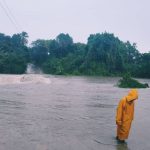In the first half of 2022, The Government of Daniel Ortega executed 65.9% of the expenditure destined to attend to the covid-19 pandemic, which translates to 1,757 million córdobas. This execution amount is higher than that observed in the same period last year when there was a slow use of the “covid budget”.
Nevertheless, this year’s budget is considerably lower than a year ago. In 2021, the allocation for the pandemic reached 6934.0 million cordobas, of this amount, the regime executed 80% in the last quarter of the year. This under-execution left the population unprotected in the face of vaccine shortages and the impact of the second wave of the pandemic.
Instead this year, with a smaller budget (barely 2,664 million córdobas), more than half has been executed in the first six months, according to the budget execution report from January to June 2022 recently published by the Ministry of Finance and Public Credit (MHCP).
According to the report, the main sources of financing this year come in 23.2% from treasury income; while 76.8% is from loans for the pandemic granted by the Central American Bank for Economic Integration (CABEI), the Inter-American Development Bank (IDB), the World Bank (WB) and the International Monetary Fund (IMF).
Also included are donations of 27.8 million córdobas from Taiwan, who was one of the countries that contributed the most funds and medical supplies for the pandemic in 202 and 2021, but that Ortega broke relations last December to ally with China; C$8.9 million from the IDB, C$232.0 million from the World Bank and one million cordobas from the United Nations Children’s Fund.
Initial budget grew 1.6 times
The initial “covid budget” was 1,584,245,196 córdobas, but C$1,080 million were added to this with which it increased to 2664 million córdobas that were distributed among the Treasury, the Mined, the Minsa and the Nicaraguan Army. The institution that received the largest amount of funds was the MHCP.
Initially this ministry had 819 million cordobas assigned, but after the incorporation of funds it rose to C$1,195 million, an increase of 218%. According to the budget execution report, 95.5% of this amount has already been executed. Among the projects allocated by the Treasury is the expansion and equipping of epidemiological laboratories in Leon, Rivas, Managua, Boaco. Likewise, improvement of the rooms of the Intensive Care Unit (ICU) and emergency rooms of 11 hospitals throughout the country.
The Ministry of Education had assigned an initial allocation of C$33,776,428 for pandemic care; but it is increased to C$232 million córdobas. The detail of the incorporations indicates that the amount was allocated mostly to the “improvement of the water, sanitation and hygiene system” of schools located in Carazo, Granada, Chinandega and municipalities of Managua such as San Francisco Libre and San Rafael del Sur.
The Minsa had been assigned C$239 million, but with the 24.6% increase, its budget rose to 1,209 million cordobas. This amount will be distributed in central activities, health promotion and disease prevention program, first level care and hospital care. As detailed in the budget execution report, only 40.3% of this item for covid has been executed by the Minsa.
The covid budget also designated an item for the Nicaraguan Army, initially this was C$39,200,000, but it was reduced to 27 million córdobas.
Execution of donations and covid loans
The execution report details that 68% of the funds allocated to the pandemic came from IMF and CABEI loans. From the first multilateral organization, 575 million córdobas were allocated from the health program and 198 million from the food program.
From the Central American Bank for Economic Integration, four programs were allocated for the pandemic amounting to 673 million córdobas under the title of “institutional strengthening”. From the IDB, C$362 million were allocated, of these 8.9 million are donated and C$353 million are from loans.
The World Bank contributed 277 million córdobas, 232 million as a donation and 45 million as a loan. The breakdown also reveals that T$27,814,421 from the Government of Taiwan and T$1,177,744 from the United Nations Children’s Fund were used.
The “covid budget” will continue to increase after the recent approval of a millionaire loan from the World Bank for 116 million dollars that will be used to buy vaccines to be applied in 2023, according to the Ortega government.
Currently, Nicaragua has a low incidence of covid-19 because the new outbreaks do not trigger serious symptoms of the disease. This has caused a further reduction in independent monitoring of the pandemic, which in the last two years was measured by the increase in hospitalizations. Likewise, the Minsa does not carry out massive tests to measure community contagion and in hospitals, cases with symptoms are treated as “suspected covid”, without referring to PCR tests.
For seven weeks, the Minsa no longer reports a single death due to covid and weekly infections remain between 42 and 47 every seven days. As of August 30, Nicaragua accumulated 19,857 positive cases, of these 14,671 would have recovered and 245 died, according to the authorities.














